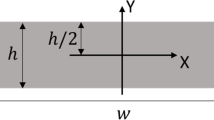Abstract
This paper focuses on the theoretical simulation of fracture and stable crack growth of specimens with non-local damage. The first law of thermodynamics allows the identification or definition of appropriate crack-driving forces. The results are compared with recent ideas on defining tearing resistance for uncontained yield through the energy dissipation rate. A hypothesis regarding the conversion of mechanical into thermal energies within the non-local damage region is formulated to model the fracture behaviour of energy dissipative materials with rising crack resistance characteristics. The material's capacity to develop non-local damage is assumed to decrease with the actual damage level. This decrease relates linearly with the remaining resources of the material in dissipating energy. The hypothesis, which proposes a square root function for theoretical J-R curves, is verified by the regression analysis of experimental data regarding a European round-robin test of different steels.
Similar content being viewed by others
References
V. Tvergaard and A. Needleman, Acta Metall. 32 (1984) 157.
P. J. Budden, and M. R. Jones, Fatigue Fract. Engng. Mater. Struct. 14 (1991) 469.
P. Will, Fortschrittberichte VDI Reihe 18 (1988) 56.
C. E. Turner, in: “Post-yield Fracture Mechanics”, edited by D. G. H. Latzko, C. E. Turner, J. D. Landes, D. E. McCabe and T. K. Hellen, (Elsevier, Barking, 1984) p. 25.
S. Aoki, K. Kishimoto, M. Sakata, J. Appl. Mech. 48 (1981) 825.
O. Kolednik, ESIS Newsletter No. 20 (1992/93) 12.
C. E. Turner, ESIS Newsletter No. 19 (1992) 10.
T. L. Anderson, “Fracture Mechanics” (CRC Press, Boca Raton, 1991).
M. Sakai, J. I. Yoshimura, Y. Goto, M. Inagaki, J. Amer. Ceram. Soc. 71 (1988) 609.
C. L. Chow and T. J. Lu, Int. J. Fract. 50 (1991) 79.
R. N. Stevens, F. Guiu, Proc. R. Soc. Lond. A435 (1991) 169.
M. F. Mecklenburg, J. A. Joyce, P. Albrecht, in “Nonlinear fracture mechanics” Vol. II, “Elastic-plastic fracture”, edited by J. D. Landes, A. Saxena and J. G. Merkle (ASTM STP 995, 1989) 594.
M. L. Braga, PhD thesis, Faculty of Engineering, Imperial College, University of London, 1992.
D. B. Marshall, M. V. Swain, J. Amer. Ceram. Soc. 71 (1988) 399.
P. Will, B. Michel, P. Kuntzsch, cfiBer./DKG 70 (1993) 23.
P. Will, Fortschrittsberichte der DKG 3 (1992) 133.
B. Hayes, et al. Final report of a European round-robin, TWI Report No. 8029/6/90, The Welding Institute, Abington, 1990.
Author information
Authors and Affiliations
Rights and permissions
About this article
Cite this article
Will, P. R curves for energy dissipative materials. JOURNAL OF MATERIALS SCIENCE 29, 2335–2340 (1994). https://doi.org/10.1007/BF00363423
Received:
Accepted:
Published:
Issue Date:
DOI: https://doi.org/10.1007/BF00363423




